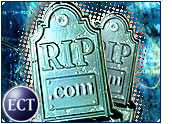
In the aftermath of the dot-com shakeout, surviving e-tailers have swooped in to buy the assets of defunct companies, relaunching once-dead sites to capitalize on existing brand names or e-tail foundations. So far, anecdotal evidence seems to show that when the price is right, bringing dead dot-coms back to life can be a sound strategy.
Almost a year ago, for example, KB Toys‘ parent company bought the domain name and other intellectual property of infamous dot-com failure EToys at a bankruptcy auction for US$3.5 million.
After several months in the dark, the EToys site was brought back to life by its new owners just prior to the 2001 holidays. So far, at least, the numbers suggest the move was well worth the investment. Just weeks after the revival of EToys.com, KB Toys saw a 27 percent increase in traffic from the year before
“Relaunching just before holidays seems to have really paid off,” Kim Pillon, an Internet analyst at Nielsen//NetRatings, told the E-Commerce Times. In fact, during November and December, 44 percent of all of KB Toys’ traffic was generated by the EToys Web site, a figure that decreased to 19 percent in January.
“You had people going back to the Web for toys and thinking, ‘Where did I go last year?’ and typing in that old domain,” Pillon said. “In that sense, it was a smart move and great timing.”
The bigger question, Pillon added, is whether the traffic means sales — and repeat sales.
Revival Meeting
Exactly what a thriving e-tailer sees in a dying or defunct dot-com can vary widely. Sometimes it is a brand name built up with costly marketing blitzes; at other times, it is a customer list. But one thing seems clear: With scores of dot-coms of all sizes in bankruptcy or available at fire-sale prices, more resurrections almost certainly lie ahead.
Webvan’s assets remain in the vault at Kaiser Permanente, which scooped them up at a bankruptcy court sale. And several other well-known dot-coms from the early days, such as Furniture.com, seem to be stuck in dot-com purgatory.
“If you can get a few million names for a couple cents per name, it probably makes a lot of sense,” David Schehr, research director at GartnerG2, told the E-Commerce Times. “But judging the value is going to be tough for anyone except those inside the companies.”
Typing Logic
Schehr said the EToys relaunch is justified by the fact that the domain name is a logical one that shoppers might stumble upon by typing in a URL that “makes sense as a place to buy toys.”
Once consumers get to the site, he added, they probably will be reassured by the KB Toys logo. “That’s a name that you see [while] walking through the mall, so they would feel comfortable buying there, I’d think,” Schehr added.
The same is true of traffic driven to Amazon.com by two of its fire-sale pickups, Egghead.com and OurHouse.com.
“Amazon is the closest thing we have to a pure Internet brand,” Schehr said.
Jury Still Out
But it may be too early yet to determine whether those experiments will pay dividends.
Amazon did not mention either site in its fourth-quarter earnings report, Morningstar.com stock analyst David Kathman noted.
“I think it will take at least a few quarters before the deals can be judged a success or a failure,” Kathman told the E-Commerce Times.
So far, he added, the data seems to be sending mixed signals. Egghead brought in US$146 million in revenue during the first six months of 2001, which could, if carried over, provide a 50 percent boost to the revenue of Amazon’s electronics segment, Kathman noted.
But Amazon’s fourth quarter showed a decrease in electronics revenue — a potential red flag.
“I wouldn’t want to make any absolute judgments just yet,” Kathman said. “But time will tell.”

















































Social Media
See all Social Media